Google has rolled out the new Google Product review update on 23rd March 2022. The update is related to Product Reviews and listicles, and it impacts the search ranking of many websites. Let’s understand what is it and how can smaller websites follow Google guidelines to improve search traffic.
The crux of the Google Product Review update is to improve the search result for people looking for genuine product reviews and advice.
The intent for the update is great, but in reality, is this making the genuine information accessible to more people? Or is it pushing big brands, keyword-stuffed pages, and websites with bought links equity to the top of the results? I analyzed some of this information, and here are some findings and case studies. I could be wrong, but here is what I have found.
Note – My intent is to highlight some of the insights about this new Google Product Review update and how it is, making the search results better or worse. I am sharing the perspective of a small publisher. I am not writing this article as an opinion but will share proof and data.
The SEO agencies have different perspectives on the matter and are mostly unaware of the limitations of publishers and how big publishers are doing most reviews.
Google Product Review Update 2022 – Case Studies and Analysis
In the product review update, Google says the reviewer (blogger) should have checked out all the products and tested them before writing a listicle. Practically speaking, I believe it is not doable for smaller and most large websites.
For writing an article like 10 Best smartphones Under Rs 50,000 – you need to buy all 10 phones and then test and review them. The budget and time for writing such an article will be in lakhs, and it will take weeks to test them and write an article.
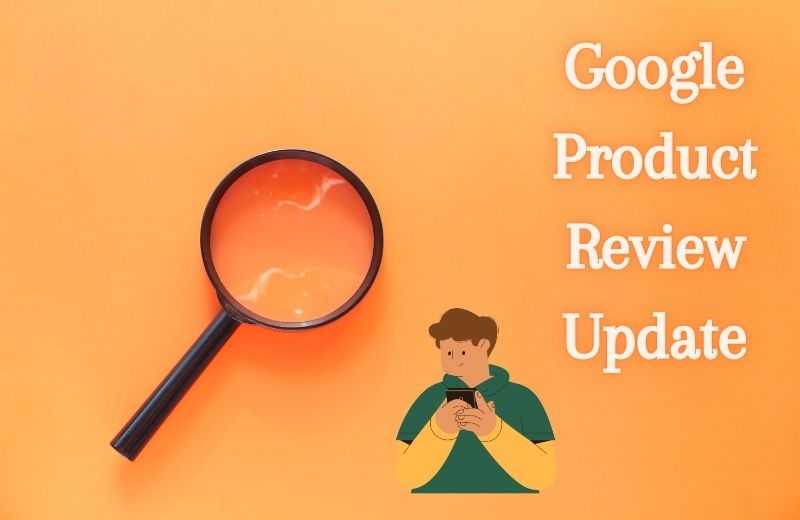
What will the blogger get out of it?
Maybe if he is lucky, a few 100 bucks. It is not viable to do it. Neither the authors at large tech websites have tested all products. Multiple authors test different products, and the listicle is probably written by someone who has not even tested a single product on the list.
It is unrealistic and absurd to expect blogs to have the resources to test, review and write about each product. They can read user reviews, analyze, summarize, state pros and cons, and test some products. But what Google is asking is not doable.
Impact of Google Product Review Update on Affiliate Websites
We have a medium size website that, in its hey-days, used to get a million visitors per month but now is reduced to just a fraction. It is a decaying skeleton similar to iGyaan.in or phoneradar.com blog that have already died.
After the recent Google Product Review Update, the traffic has gone down by about 80% of what the website was getting. Years of effort into writing high-quality content looks wasted. I am sure there would be many more in the same boat. I checked the Alexa ranking of several small websites, and all seem to have got hit.
The guys who are not hit are commercial websites or large brand names, at least in the tech niche. I have checked 100s of keywords that are now dominated by large websites with worse outdated content.
However, Google somehow thinks that if a website has a high (E-A-T) due to publishing a huge volume of daily content or buying backlinks, that website is worth showing on the top of the results.
I see Flipkart, Amazon, bajaj-Finserv, Cashify, and several other large websites ranking at the top (for similar keywords like best smartphones under 20,000) – these folks have never done a detailed smartphone review in life. Most of the writers are inexperienced, hired for doing the quick work. They don’t have experience or an in-depth understanding of topics. But the brand name is big and is the so-called E-A-T. So these folks are ranking for all queries.
Case Study 1 – Google Product Review Update
Let me share some examples of how Google pushes down smaller websites despite some articles having incredible content.
It took me many days to write an article on “Made in India Smartphones”. The article was written more than 3 years back and has been updated many times. It has more than 200K views. It used to rank on the No.1 position for the keyword “Made in India Smartphones”. The article has received 100s of comments.
After the recent update, Google pushed poorly written articles from Bajajfinserve and Cashify to the top of the result. Both are commercial websites that buy links from all major publications to dominate the search results. I have emails from their SEO team to sell them links, but I never did.
These websites are not even writing content for readers; they sell EMIs and other products to the organic traffic. They don’t care about the end reader or why is he searching this topic.
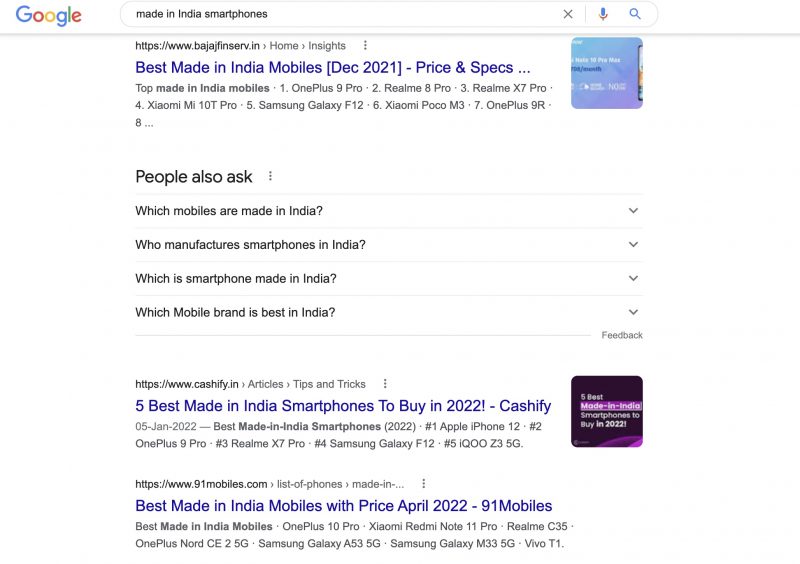
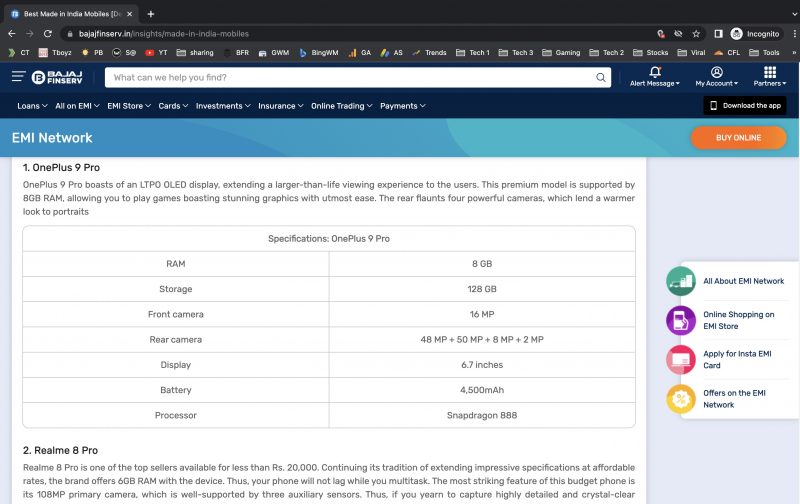
That is still fine if the content was good and better than what I managed to write after spending days on my article.
Let’s have a look at the content. Just read the underlined part of the article – how much is the keyword stuffing in the article. My god, we were back in 2008, I guess. Keyword stuffing is a thing now:)
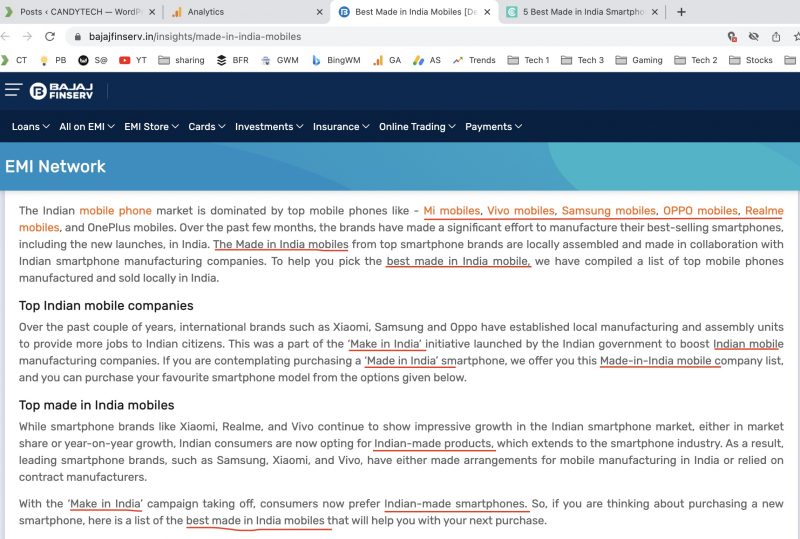
Why Should Cashify be left behind in the race of keyword stuffing – let’s do it, boys, rule the search and make a fool of small publishers and search teams.
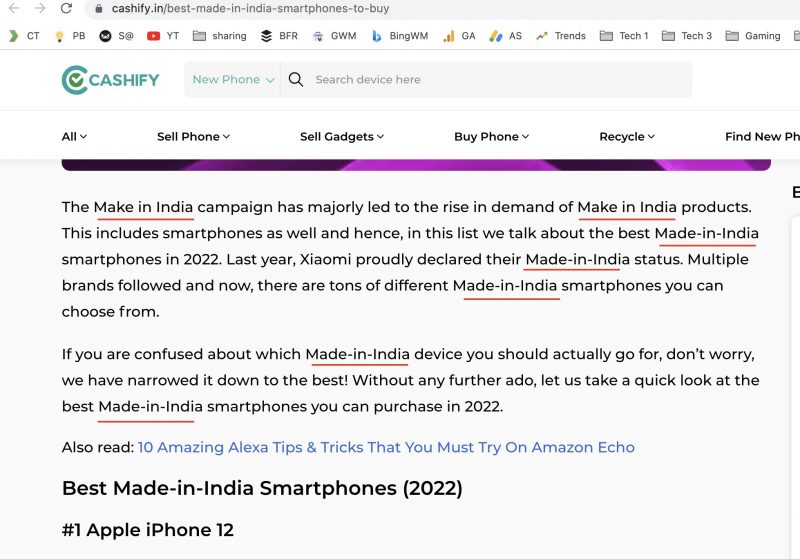
Cashify is a website that has nothing to do with the information but uses the blog to drive traffic for the purchase and sale of used electronics and other products.
The key aim for the Bajaj Finserv website is to sell phones on EMI and are optimized for that. Nevertheless, the content, user experience, and website design are poor. There is no information about the author on the Bajaj website, and the other has a very poor author description. What you can learn from this is Author and who is writing the article doesn’t matter as long as you can buy the links.
Unfortunately, Google doesn’t care who the author is anymore, his profile, or his years of experience. Author profiles were dropped by the search giant. Backlinks and Brand names matter a lot more.
This is just one example. I have several more keywords and examples where the search results have deteriorated. Maybe, the intent of the product review update was not bad, but the results aren’t convincing.
We need to understand whether these websites ranking in serps have Genuine E-A-T, are these made for sharing information, do they care about the reader’s pain. Nope, they are commercial websites to push their own business.
However, Google thinks since they don’t have Amazon/other affiliate links, these are offering valuable information.
Case Study 2 – Google Product Review Update – NewIndiaExpress
Another website that has gained massively after the update is the new https://www.newindianexpress.com/expressdeals/. You can copy the link and visit and check the website. The website has Zero product reviews – literally, they never tested any product.
Another funny thing is there are no author descriptions or images in the articles. They are just writing some text. The website has a poor design and clearly looks spammy. They are writing on products from Glucometer to face creams to laptops, smartwatches, and gaming laptops. There is no niche, no expertise, and no useful articles. Just affiliate articles written by anonymous writers to make money. The domain is also not very old.
Don’t just trust me. Do your own validation.
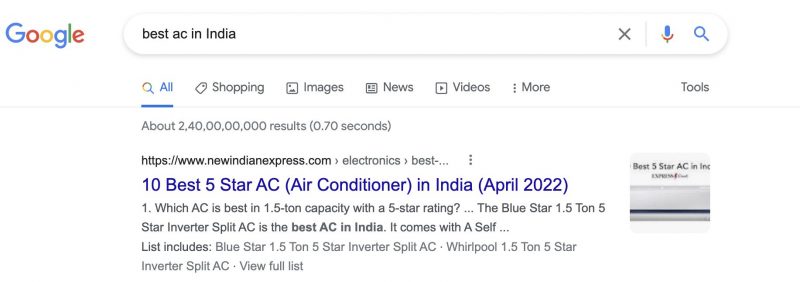
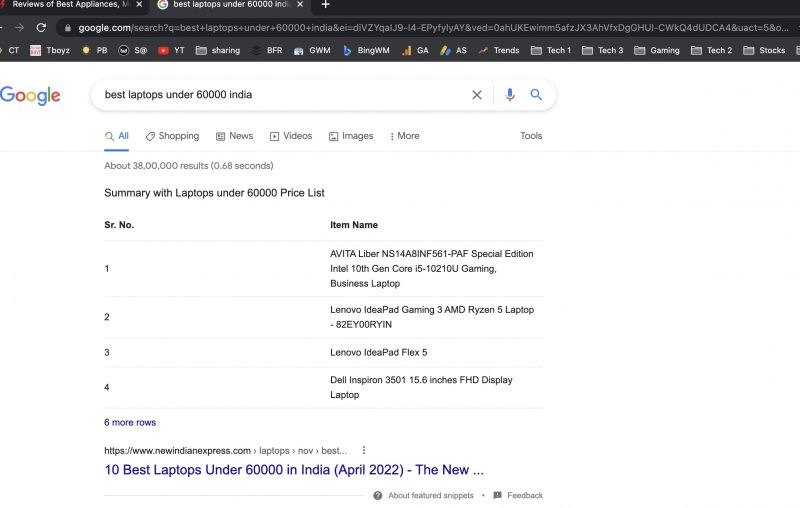
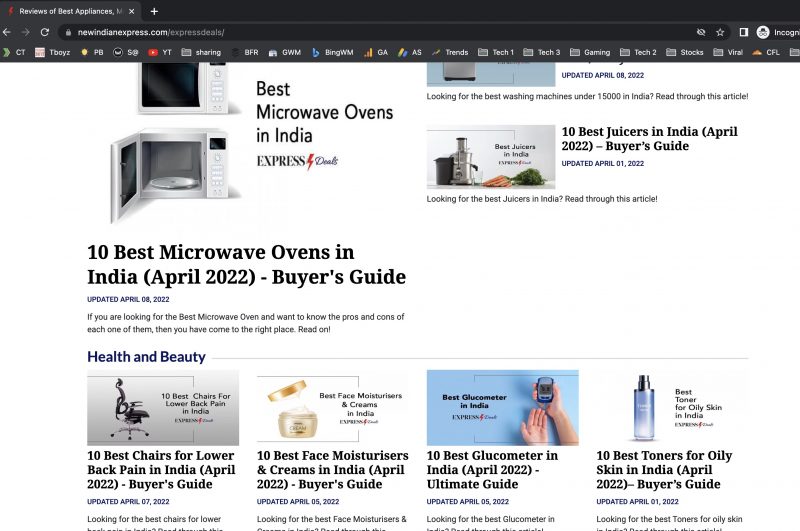
Why the website is Ranking No.1 on Google for a lot of competitive keywords? Because it is part of the NewIndiaexpress domain, a news website, and a large publisher with a zillion links and domain authority. Also, these guys are using a content template that is good for showcasing fake authority. Can actually go and read some articles.
Case Study 3 – Product Review Update
Another website shares the same design and content as the newindianexpress – probably made by the same fellows. Both are fake websites – no original testing and work. A content template is used for all articles with a strong emphasis on showcasing fake testing and reviews. No original images, no author details. Absolute garbage, in my opinion.
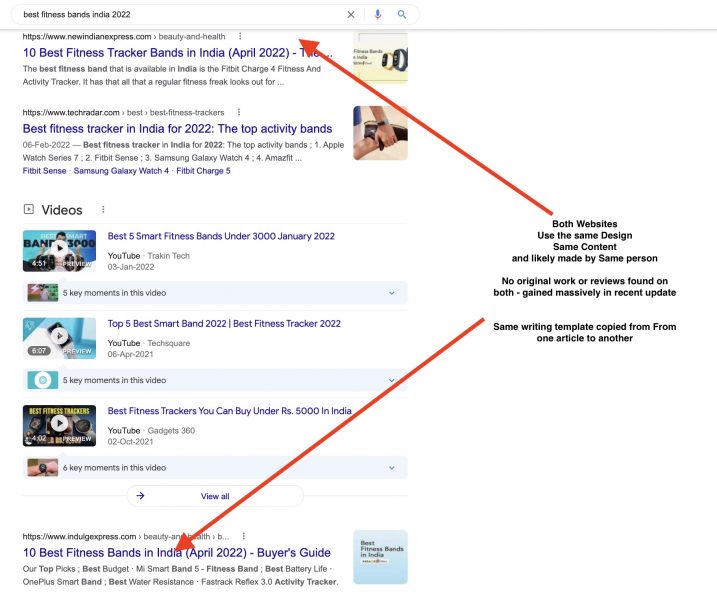
Check the content on both the websites – it is also similar – Google is still showing both in the top results:
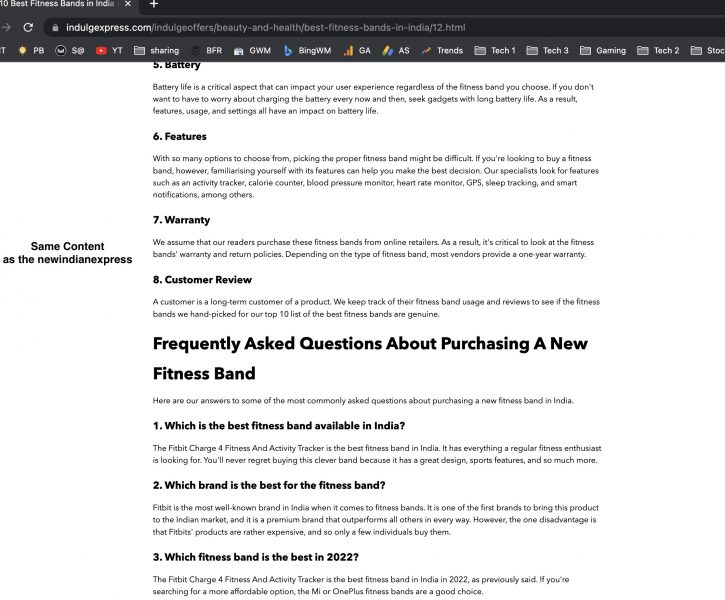
Below is the screenshot of the newIndiaexpress – They also use the same content template for all articles with exactly the same words. They are probably using an AI writer to rephrase the wording. Rest all is the same. Very clever work, and it fooled Google for sure!
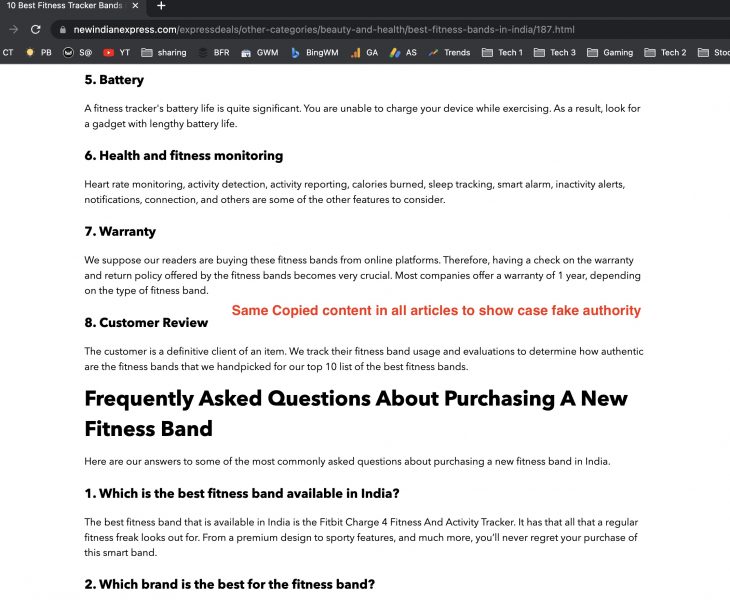
I am sure the authors who wrote these articles have no expertise in the domain. Nevertheless, these websites now rule the Google serps, and, unfortunately, smaller websites that wrote incredible content are no longer seen.
Individual Pages and Quality – Does it Matter Anymore?
What happened to the Individual Page and its Quality, freshness of content, and user experience? – What happened to the Quality Rater’s Guidelines. Everything is gone for a toss; Google now ignores nearly everything but respects the website’s brand name and fake E-A-T acquired by purchasing backlinks.
This is bad for the searcher as they are also getting crappy outdated results on the top. There are multiple ads at the top of search results by the same big brands or some of the spammy websites that both Google and Amazon fail to remove.
Paid and Sponsored Reviews
I have been in the Indian Tech Industry for the last 8 years, and most brands hate publications that state Cons. Stating Soft Cons are okay, but they despise you when you mention some real negatives. They won’t send products for reviews if you dare to mention the negative. Most of India’s large YouTube Channels and Tech websites do paid reviews. Unfortunately, that is the harsh reality of product reviews. The first-day reviews that most publications and Youtube channels publish are mostly paid by the brands either in cash or in kind.
What is the authenticity of such reviews that Google emphasizes and weighs so much on?
Creating and maintaining listicles is hard work. You can’t write an article like “Best Smartphones under 50,000” and then forget about it. New phones are launched every week/month, and the list needs to be reviewed and updated with relevant content. You need to track the launches in each segment to have a great list. Reviewing and testing products is fine; many tech products are similar. Ideally, if you review some of the phones in the price range, you have a fair idea of what to expect from others. For instance, if I test the phones with the same processor and camera sensor, I am sure about the performance it will offer in another model. If you test the MIUI 13 (Xiaomi OS Skin) in one phone, it stays the same.
The fellow writing a listicle for a big brand has one job – writing listicles. He doesn’t usually test and review products; it is done by another reviewer. How can Google rely on this guy’s judgment who has very limited exposure and knowledge? God knows!
Small publishers can freely state the Cons and negatives; the big paid guys can’t. The algorithm update forces readers to view paid/sponsored content by big brands. If we look at Youtube Tech Videos, it is mostly dominated by paid creators who get the products first from the brands, and genuine creators who buy and review are shutting down channels.
Doorway Affiliate Sites – Are Winning!
I have repeatedly asked Amazon and Google to remove doorway affiliate websites that use Google Ads to outrank genuine bloggers. But they don’t care. I have written several emails and complaints, but they hardly respond or want to take action against thin affiliate websites using Google Ads to drive traffic to Amazon and other affiliates.
Below is an example of a thin doorway affiliate website that buys Ads and makes money using Amazon affiliates.
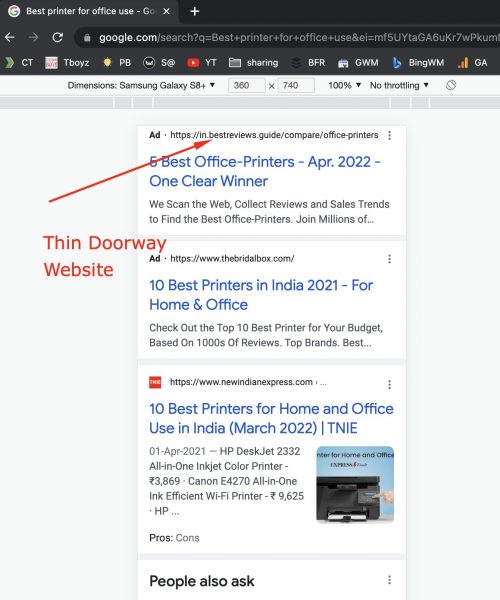
Life is sad being a blogger, especially in India. Most of them have already died or are struggling to become YouTubers.
Linking to different E-Commerce Websites – Harsh Truth
In the product review update, Google also states that publishers should link to different affiliate websites and give users a choice. In India, just one affiliate network pays some money – Amazon India. I have worked with Snapdeal.com and Flipkart.com in the past.
Snapdeal stopped the affiliate program long back. Paytm also had an affiliate program 6-7 years back, but they shut it. Infibeam had an affiliate program that was closed.
Flipkart continues the affiliate program, but they don’t pay any commission. Here is what GeekyRanjit has to say on the matter. I have checked with several publishers, and Youtubers all have lost money. Flipkart is a big fraud when it comes to affiliate marketing.
Why Should Flipkart get free traffic? Nearly everybody has stopped linking to them for many years.
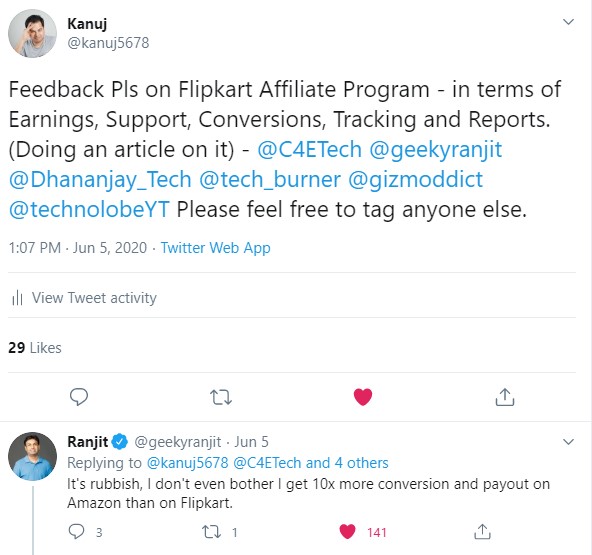
What can Small Websites and Affiliate Blogs Do?
In fact, after the update, we removed most ads and affiliate links from our website and made the website free for visitors. We are not getting much traffic nor earnings, and as long as Google thinks we are a thin affiliate website, there is no hope of gaining traffic back. Also, I am sure that if things don’t improve in the next 2-3 months, we will have to close shop like several smaller websites. We can’t sustain the expenses for very long. Of course, it is our loss, and 8 years of effort are wasted. Still, the loss will be for the readers looking for detailed and genuine content written by an experienced and genuine writer, not some commercial shit from a conglomerate that has bought 100s of links and ads to get the rankings.
Concluding Thoughts – Product Review Update
The folks at Google probably have no idea about the damage this is doing to genuine content writers and bloggers. It is nothing new; in the last 8 years, I have seen several SEO penalties – Panda, Penguin, and the rant to keep the quality higher. But quality doesn’t matter if you have a big brand name or if you can buy backlinks. The Guidelines and penalties are for small folks who can’t spend dollars.
Google has done many good things in the past, and letting blogs survive would have been another positive. But going by the trend, they are making it very hard. It’s not my job to write about these things. All I want from them is to fix the ranking for my website and other deserving websites for the sake of bloggers and their staff whose livelihood depends on it.
Google is the Gate-Keeper of the internet, and I think it is way better than Facebook (Meta), but some of the things that the company has done are neither in favor of searchers nor smaller businesses. Google doesn’t owe anything to smaller businesses, but they owe it to the searchers and content websites following their guidelines.
The new Product review update is not what we expected, and Google should revert it and focus more on the quality of the individual pages served to the searcher for the keyword rather than blanket push for big media with useless, outdated thin content or fake E-A-T.
Additional Resources and Further Reading:
https://developers.google.com/search/blog/2022/03/product-review-ranking-one-year-on
https://developers.google.com/search/docs/advanced/ecommerce/write-high-quality-product-reviews
https://developers.google.com/search/docs/advanced/guidelines/affiliate-programs

